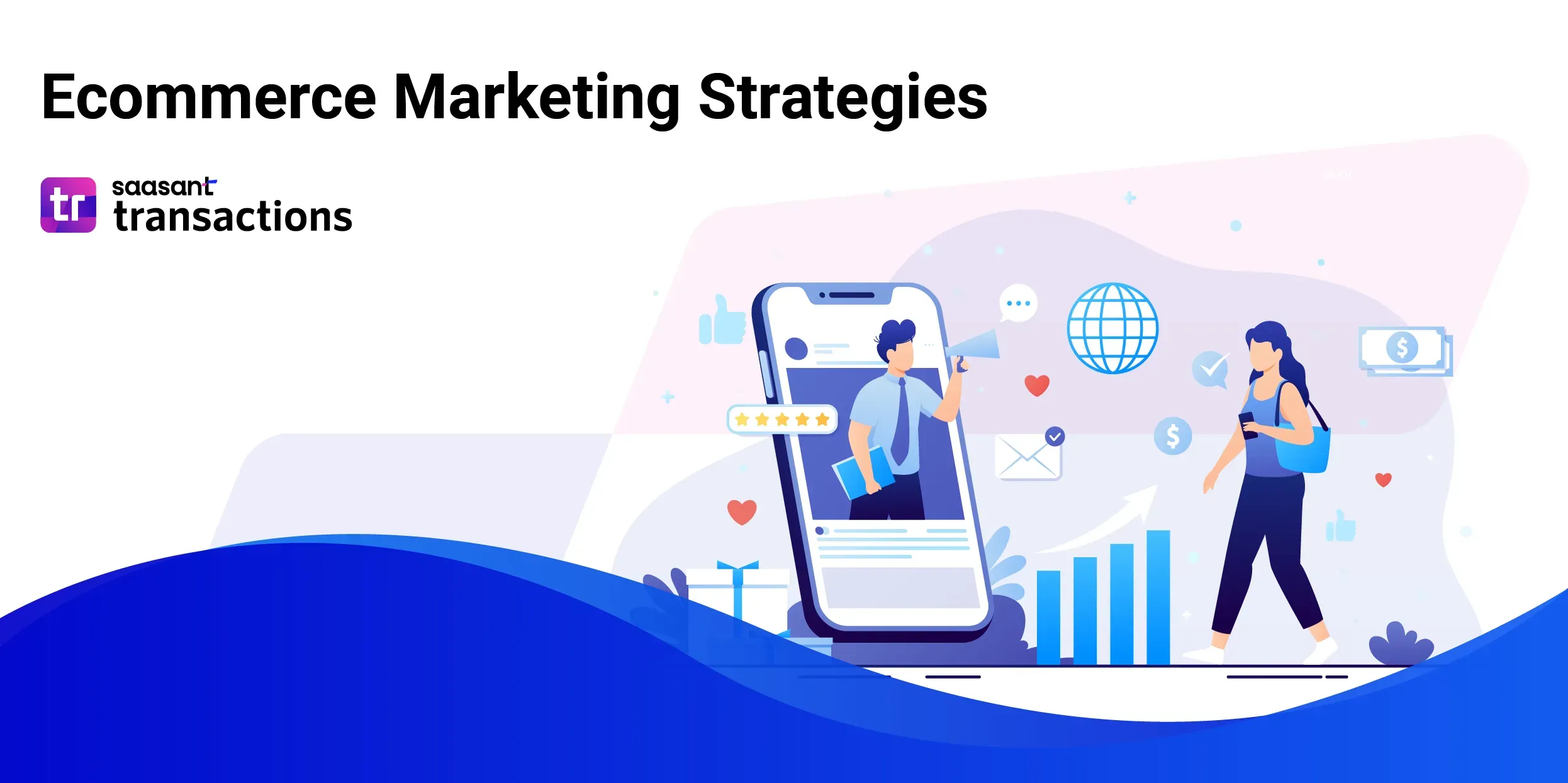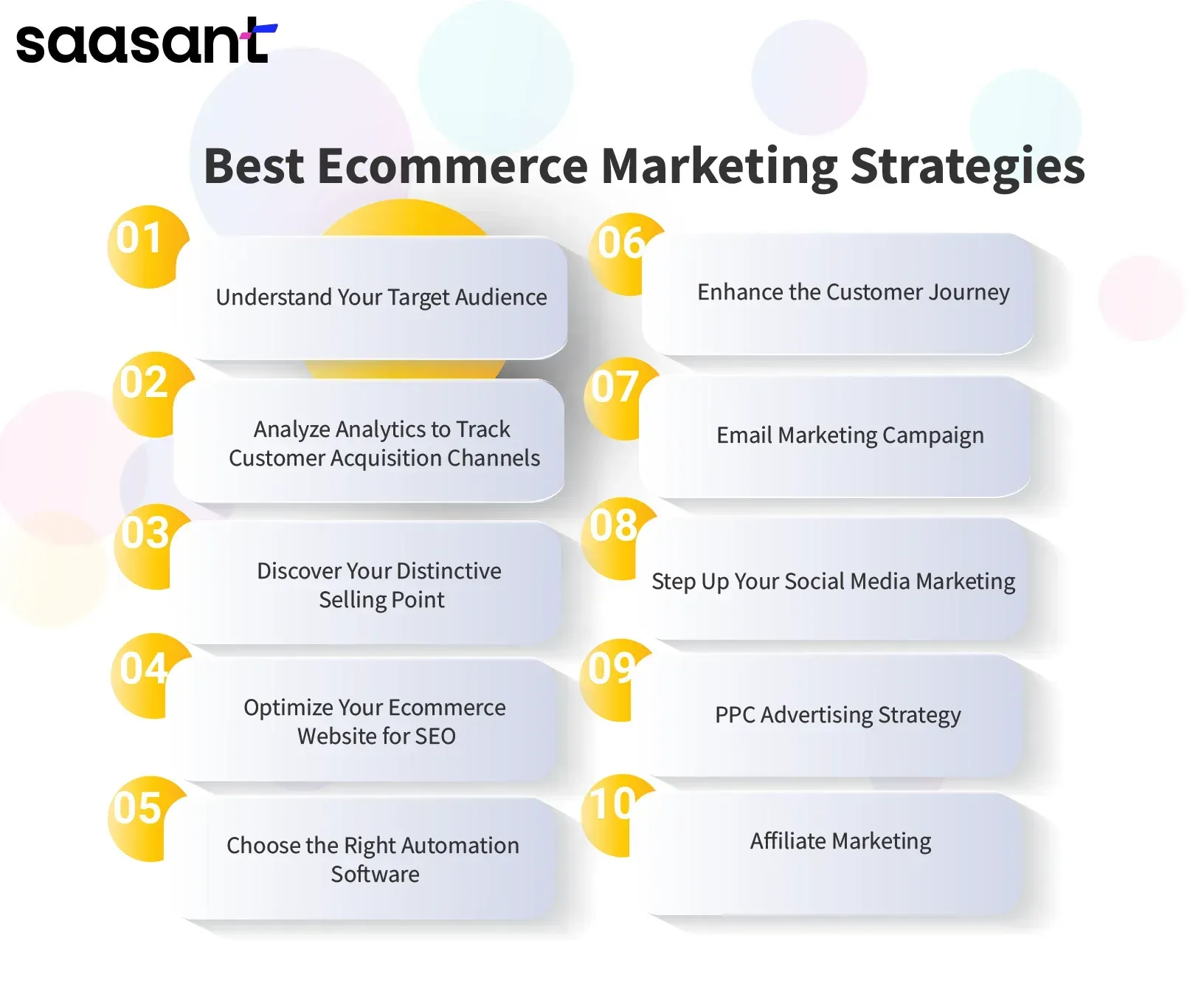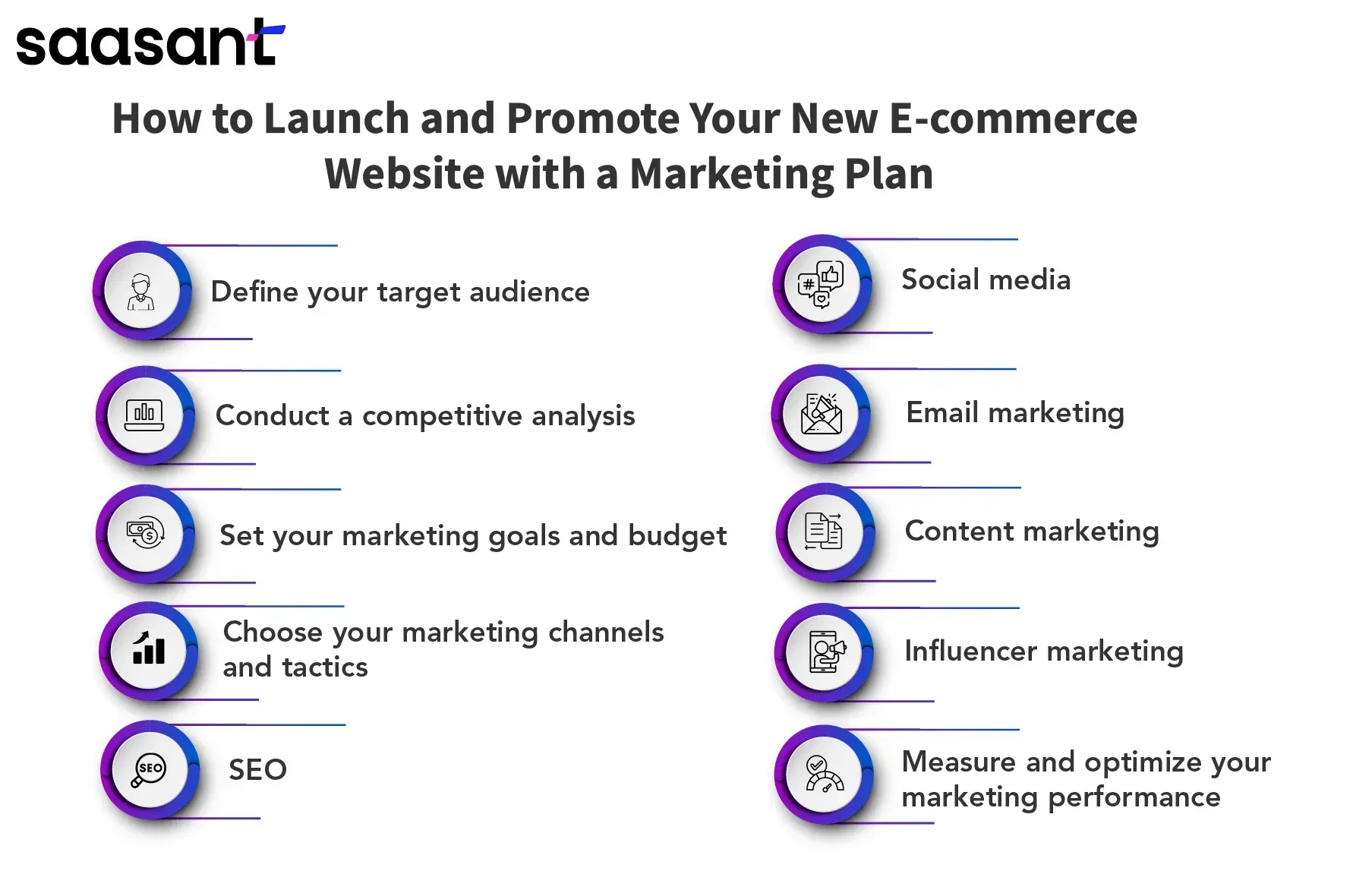10 Best Ecommerce Marketing Strategies to Boost your Online Sales 2024

eCommerce marketing uses social media channels and strategies to promote and sell products or services online. It is essential for online businesses because it helps them reach and attract their target audience, increase brand awareness, generate more traffic, conversions, and revenue, and build long-term customer loyalty.
This blog will discuss the top 10 eCommerce marketing strategies for boosting online sales. Whether you are a new or established online business, you will find something valuable and actionable in this post.
Contents
10 Best eCommerce Marketing Strategies to Boost Your Online Sales
How to Launch and Promote Your New eCommerce Website with a Marketing Plan
How to Create an eCommerce Marketing Strategy?
Conclusion
FAQs
10 Best eCommerce Marketing Strategies to Boost Your Online Sales
eCommerce marketing uses strategies to build brand awareness and engage potential customers from the initial sales funnel stage. Successful implementation of these strategies drives traffic to the website and converts visitors into active buyers, resulting in enhanced sales performance and a loyal customer base.
Let’s look at the 10 best eCommerce marketing strategies to boost your online sales:

Understand Your Target Audience
It's crucial to deeply understand your target audience to make informed decisions about your products and eCommerce marketing strategies. You can directly engage with customers in an offline store to gauge their preferences and interests. However, proactive measures are necessary in an online store to gather insights about your customers.
Using analytics tools within your online store and point-of-sale (POS) system enables you to uncover purchasing trends and customer preferences. While face-to-face interactions are invaluable, you can use various channels such as email, online chat, and phone calls to ask pertinent questions and gain valuable insights into your customer base.
Discover Your Distinctive Selling Point
Discover your unique selling proposition by identifying what differentiates you from the competition. What narrative defines your store, products, and personal brand?
Once you've pinpointed your distinctiveness, amplify it across various platforms. Incorporate it into your tagline, display it on your homepage, showcase it in social media advertisements, and emphasize it in email marketing campaigns. Centering your eCommerce marketing strategies around your unique selling proposition gives potential customers a compelling reason to visit your online store and purchase.
Analyze Analytics to Track Customer Acquisition Channels
Utilize analytics tools to understand the pathways customers take to discover your store. Maximizing your time and marketing budget is essential. You can optimize your marketing strategies by employing tools like Google Analytics to analyze how purchasing customers are finding your store. For instance, if a significant portion of your cookware store's traffic originates from a blog post about healthy eating, creating more related content is beneficial. Similarly, if most of your sales are generated from Facebook ads, considering additional investment in advertising might be worthwhile.
Optimize Your eCommerce Website for SEO
With so many competitors looking for customers’ attention, you must ensure your eCommerce website is optimized for SEO and user experience. SEO, or search engine optimization, improves your site’s visibility and relevance in search engines like Google. User experience, or UX, enhances your site’s usability, accessibility, and desirability for your visitors.
By optimizing your e-commerce website for both SEO and UX, you can achieve several benefits, such as:
Increase your organic traffic and conversions.
Reduce your bounce rate and cart abandonment.
Build trust and loyalty with your customers.
Gain a competitive edge in your niche.
Choose the Right Automation Software
Choosing the best automation application is crucial for streamlining your business operations. Whether you opt for QuickBooks or Xero to enter your sales transactions, ensuring the software aligns with your needs and offers robust automation capabilities is essential. Additionally, applications like PayTraQer can enhance efficiency by automating e-commerce bookkeeping processes, saving time, and reducing manual errors.
Enhance the Customer Journey
Streamline the customer experience by ensuring simplicity. Your goal is to make it effortless for customers to find and purchase what they need. If your analytics reveal a high bounce rate—where visitors leave without completing a purchase—consider refining your customer experience.
Invite friends and family representing your target audience to navigate your online store and complete purchases. Observe their journey for any hurdles or confusion, focusing on the website's search functionality, product navigation, and checkout process.
Email Marketing Campaign
Email marketing is an effective eCommerce marketing strategy. The initial step in launching an email marketing campaign is to collect your customers' email addresses.
eCommerce websites can achieve this through various methods, such as offering a special deal or a free downloadable resource (like a template or checklist) in exchange for an email. Once you've collected email addresses, it's crucial to maintain contact with potential customers by sending them timely and relevant emails.
Step Up Your Social Media Marketing
An essential part of any eCommerce marketing strategy is meeting customers where they are and focusing on your strategies in those areas. Spending half your yearly marketing budget on advertisements they’ll never look into is ineffective. Since most Americans (70%) use social media daily, establishing a presence on social media platforms is essential.
Engage with your audience. Post updates about new products or awards, promote contests, solicit feedback, and share content created by your users. By consistently using the same tone and personality on social media as your other marketing materials, you'll guide potential and existing customers to your website.
PPC Advertising Strategy
PPC advertising, short for pay-per-click advertising, is a marketing strategy where you incur a charge each time a user clicks on your advertisement. These ads can be displayed on various online platforms such as search engines, social media, websites, and apps, giving you flexibility based on your objectives and preferences.
One significant advantage of PPC advertising is its ability to generate immediate website traffic and target potential customers actively seeking your products or services. Additionally, PPC tools such as Google Ads or Facebook Ads make assessing your performance and return on investment convenient.
Affiliate Marketing
Affiliate marketing is an eCommerce marketing strategy that involves collaborating with external entities such as websites, influencers, or publishers. These partners promote your products or services to their audience and earn a commission for each sale or specified action they contribute to. By engaging in affiliate marketing, businesses can broaden their reach, enhance brand awareness, and generate additional sales and leads through the efforts of their affiliate partners.
The primary advantage of affiliate marketing lies in its cost-effectiveness and low-risk nature, as payment is made solely based on the actual results achieved. This performance-based model ensures that businesses only pay for the outcomes generated by their affiliates. Additionally, affiliate marketing allows companies to leverage the trust and authority of their affiliates, tapping into their niche and loyal audience, which can significantly enhance brand credibility and reach.
How to Launch and Promote Your New eCommerce Website with a Marketing Plan
Launching and promoting a new e-commerce website can be daunting, but with a solid marketing plan, you can achieve your goals and grow your online business. A marketing plan is a document that outlines your marketing objectives, strategies, and tactics and how you will measure and optimize your performance.
Here are some steps to create and execute a marketing plan for your new e-commerce website:

Define your target audience.
Conduct a competitive analysis.
Set your marketing goals and budget.
Choose your marketing channels and tactics.
SEO.
Social media.
Email marketing.
Content marketing.
Influencer marketing.
Measure and optimize your marketing performance.
How to Create an eCommerce Marketing Strategy?
To develop an effective eCommerce marketing strategy, follow these concise steps:
Identify Your Audience: Understand who your customers are based on demographics and behaviors.
Analyze Competitors: Study your competitors to identify what works and where you can improve.
Set Goals: Define clear objectives like increasing sales or improving brand awareness.
Choose Channels: Select the digital platforms where your audience is most active.
Develop Content: Create appealing content that aligns with your brand and meets audience needs.
Optimize Your Website: Ensure your site is user-friendly and optimized for conversions.
Apply SEO: Use SEO techniques to enhance your visibility on search engines.
Use Email Marketing: Engage directly with customers through tailored email campaigns.
Monitor Results: Track your strategy’s effectiveness with analytics tools and adjust as needed.
Refine Continuously: Keep improving your strategy based on feedback and data insights.
Conclusion
Using these 10 best eCommerce marketing strategies can significantly boost your online sales. Each strategy plays a crucial role in building a robust online presence, from understanding your target audience to leveraging the power of SEO and automating processes. Remember, the key to successful eCommerce marketing lies in integrating these strategies effectively and continuously optimizing them based on performance analytics.
FAQs
What is the marketing strategy of eCommerce?
An eCommerce marketing strategy includes the methods you want to implement to promote your online store and boost sales. This strategy represents a long-term vision for the direction of your eCommerce business. It is formed based on your understanding of the market, current trends, consumer insights, brand values, and product offerings.
What are the 5 marketing strategies?
The five key marketing strategies include:
Product Strategy: Deciding on the product offerings, features, and design.
Price Strategy: Setting competitive pricing and discount structures.
Promotion Strategy: Communicating with your market through advertising and digital marketing.
Place Strategy: Determining how and where your products are sold to customers.
People Strategy: Focusing on customer service and enhancing the customer experience.
What is an eCommerce strategy?
An eCommerce strategy is a go-to-market campaign that promotes your product to boost online sales. However, it extends beyond mere marketing to encompass all aspects of a product. This strategy is crucial for attracting new and returning customers and driving increased demand.
What is eCommerce advertising?
eCommerce advertising involves paying to promote a product online through paid messages. The advertiser compensates for placements, impressions, clicks, and other forms of engagement on platforms such as Facebook, YouTube, or TechCrunch.